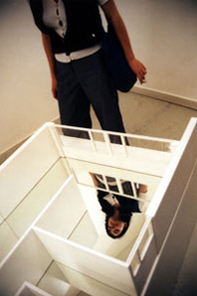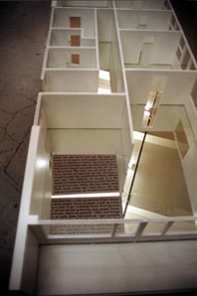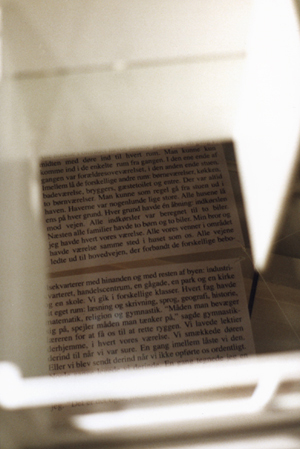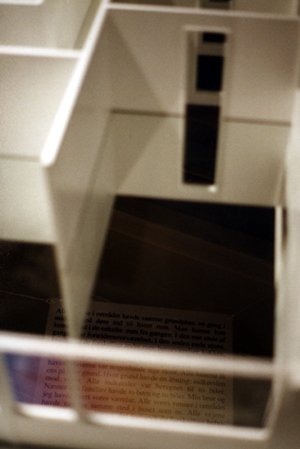| Katya Sander | e@katyasander.net |
| All Of The Houses In The Area II 2000 architectural model with mirror and text   
The center of the piece was a model of my mother’s house built on a scale of 1:50, approximately the size of a bed. The floor of the model was a mirror. On the ceiling in the exhibition space, above the model, there was a text printed backwards which wasn’t particularly noticeable until one looked down into the model. In the mirror the text overhead became legible, appearing behind the image of one’s self, fragmented by the walls of the small rooms.
The text was about living in my mother’s house and its spatial logic, as well as the parallel spatial logic of the system – or ‘society-machine’, if you will – in which the house and its inhabitants played their parts. I was especially interested in the physical movement between the rooms of the house, and the logic that the floor plan implied. I drew attention to this in the model version of the house by reconfiguring the entrances and exits of the rooms, following a logic that is the opposite, or the “mirror,” of the logic of the real house in which I had lived. The text (originally printed backward on the ceiling above the model): “All of the houses in the area had the same floor plan: a hallway in the middle with doors that open into each room. The rooms were not connected, one could only enter each from the hallway. At one end of the hall was the parent’s bedroom, on the other end, the living room. In between were the children’s rooms, the kitchen, the bathroom and the entrance hall. All of the houses had two children’s rooms. All of the houses were on lots with one opening only: the driveway into the street. All of the driveways were built for two cars. Most families had two kids and two cars. My brother and I each had our own room. All our friends had their rooms in the same part of the house as we did. All of the streets led to the highway nearby, which connected the suburban area to the rest of the city – to the industrial area, the service area, the commercial center, and the area with museums, a park, and a school. That's where we went to school. We were in different grades. Each subject had a different room: language, geography, history, mathematics, sports. ‘The way you move is the way you think’, the sports teacher once said, reminding us to straighten our backs. We would do homework at home, each in our own room. We would go there when we were angry, or when we were told to go there when we didn’t behave. ‘Come back out when you remember your manners’, my mother used to say. Sometimes we would play there. I once made a drawing on the wall over my bed. My parents got angry when they saw it. ‘I thought it was my room’, I argued, very upset. ‘It is, but its our house’, they said.”
Shown in: Models of Resistance, curated by Globe, Overgaden, Copenhagen, 2000. Take Off, Aarhus Art Museum, Aarhus, 2001. |

